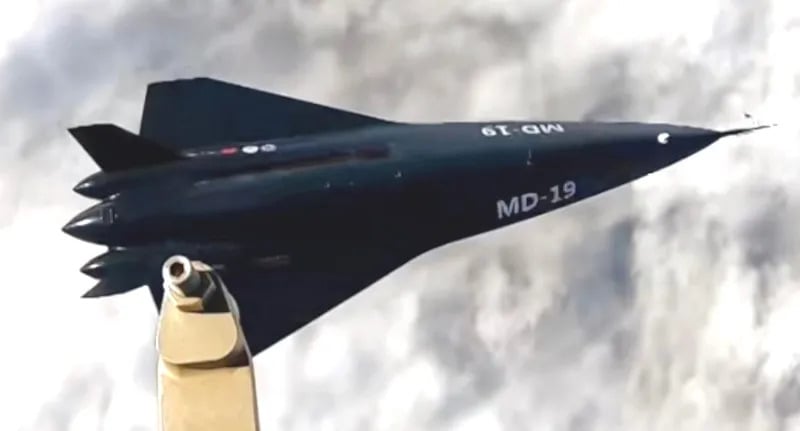(CLO) The Chinese Academy of Sciences (CAS) has released a video revealing the successful test of the MD-19 unmanned aerial vehicle (UAV). This is the first time this advanced high-speed system has been officially revealed.
MD-19, developed by the "Qian Xuesen Science and Technology Youth Task Force", a research group named after the famous aerospace engineer.
During the tests, the MD-19 was launched from both the TB-001 twin-tailed drone and a high-altitude balloon. Images and videos showed the MD-19 being launched mid-flight from the TB-001 and landing on a conventional runway, but it was unclear whether the vehicle was powered or relied solely on glide to land.
Video reveals China's hypersonic drone launch for the first time. (Source: CAS/SCMP) X [embed]https://www.youtube.com/watch?v=m04G-rskO58[/embed]
The MD-19 is about 2.5 to 3.35 meters long, smaller than its predecessor, the MD-22, a hypersonic model unveiled two years ago. The TB-001 drone, which serves as the launcher, is nearly 10 meters long. The MD-19 underscores China’s growing capabilities in hypersonic and near-space technologies, strategically important areas in the global defense competition.
The test flight is part of China’s efforts to develop hypersonic vehicles that can operate at speeds exceeding Mach 5, evading missile defense systems and conducting precision strikes. Integrating the MD-19 with the TB-001 also represents progress in multi-platform operations, combining UAVs and hypersonic vehicles to achieve cross-domain maneuverability.

A model of the MD-22 on display at the 2022 Zhuhai Airshow. Photo: Handout
Notable among the tests was the MD-19’s horizontal landing capability, a significant step forward in demonstrating the development of recovery and reusability, which are critical for cost-effective hypersonic systems. This development has not only military but also civilian applications, expanding China’s capabilities in the hypersonic and near-space domains.
The successful test of the MD-19 also reflects progress in MD testing in general. Developed by a research team from the Institute of Mechanics (IMECH) of the Chinese Academy of Sciences (CAS), the team has conducted multiple test flights with different UAV models, including the MD-21, MD-22, and now the MD-19. The success of these test flights will serve as a foundation for future hypersonic developments, including next-generation weapons and surveillance systems.

MD-19 after being dropped from the TB-001 drone. Photo: Chinese Academy of Sciences
The successful flight of the MD-19, along with the development of the MD-22 hypersonic drone, highlights China's continued advancements in aerospace, particularly in hypersonic and space technology, as part of a broader strategy to strengthen the country's military and civilian technology research.
“We are currently developing a new generation of aircraft to build long-range hypersonic vehicles faster and more efficiently,” said Liu Wen, associate professor at IMECH. China’s investments in innovative research are laying the foundation for transformative advances in science and technology.
Since 2021, CAS has established 188 task forces, named after pioneering scientists such as Qian Xuesen, to tackle major scientific challenges. These teams have achieved many breakthroughs in basic science and technology.
For example, the "Li Siguang Tibetan Plateau Paleontology Task Force" discovered the evolution of basins in the North Qiangtang Block and discovered large coal deposits in the Permian. Similarly, the "Wang Dezhao Deep Sea Task Force" developed China's first combat-capable unmanned underwater vehicle.
Ngoc Anh (according to SCMP, Defence Blog, TWZ)
Source: https://www.congluan.vn/trung-quoc-lan-dau-cong-bo-video-thu-nghiem-sieu-uav-vuot-am-post326188.html


![[Photo] Prime Minister Pham Minh Chinh receives Deputy Prime Minister of the Republic of Belarus Anatoly Sivak](https://vstatic.vietnam.vn/vietnam/resource/IMAGE/2025/4/2/79cdb685820a45868602e2fa576977a0)
![[Photo] Comrade Khamtay Siphandone - a leader who contributed to fostering Vietnam-Laos relations](https://vstatic.vietnam.vn/vietnam/resource/IMAGE/2025/4/3/3d83ed2d26e2426fabd41862661dfff2)

![[Photo] Special relics at the Vietnam Military History Museum associated with the heroic April 30th](https://vstatic.vietnam.vn/vietnam/resource/IMAGE/2025/4/3/a49d65b17b804e398de42bc2caba8368)

![[Photo] Moment of love: Myanmar people are moved to thank Vietnamese soldiers](https://vstatic.vietnam.vn/vietnam/resource/IMAGE/2025/4/3/9b2e07196eb14aa5aacb1bc9e067ae6f)

























































































Comment (0)